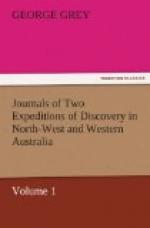THE MURRAY RIVER.
On the 12th we started before dawn and travelled about eight miles in a south by east direction; we then halted for breakfast on the banks of the same river, which here issues out of the Darling Range after having found a passage through that chain of mountains. Whilst breakfast was preparing I walked up into the mouth of the gorge, which was replete with most wild and beautiful scenery at this point. The river comes streaming out from a rocky mountain pass, forming in its course a series of small cataracts. The vale in which it runs offers an interesting specimen of woodland scenery, and the high, bold, and partially bare granite mountains which rear their heads above it differ much in character from the tame mountain scenery that lies between Perth and York: this place is a favourite resort of the wild cattle, and we saw everywhere numerous recent traces of them.
WILD CATTLE.
In the afternoon we again started in a south by east direction. About a mile after leaving the Murray we came suddenly upon four head of wild cattle; two, which were distant from us, made off to the mountains, but a noble white bull and a cow followed a line lying exactly in the course we were pursuing. As we had one saddle-horse, which I was then on, I could not resist having a gallop after them. I soon brought the bull to bay, but when he had taken breath he turned and made off again and, as I had no time to spare, I gave him no further interruption; on however wishing to ascertain the hour I found that my watch had fallen from my pocket during the course of the gallop.
NATIVE TRACKING.
I now waited until the party came up, when I requested Kaiber the native to walk back and find the watch. This he assured me was utterly impossible, and I really at the time agreed in this opinion; however as it was a watch I much valued I determined to make one effort. “Well, Kaiber,” I said to him, “your people had told me you could see tracks well, but I find they are mistaken; you have but one eye, something is the matter with the other (this was really the case) no young woman will take you, for if you cannot follow my tracks and find a watch I have just dropped how can you kill game for her.” This speech had the desired effect, and the promise of a shilling heightened his diligence, and I returned with him. The ground we had passed over was badly suited for the purpose of tracking and the scrub was thick; nevertheless, to my delight and surprise, within the period of half an hour my watch was restored to my pocket. This feat of Kaiber’s surpassed anything of the sort I had previously seen performed by the natives.
We completed about eight miles and then halted for the night on the banks of a running stream issuing from a gorge in the hills. There was a considerable portion of good land in its neighbourhood and the horses appeared not a little pleased with the excellence of the feed.




